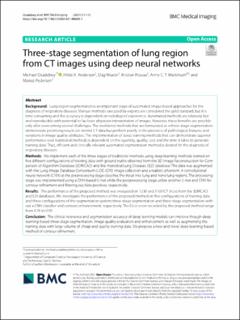| dc.contributor.author | Osadebey, Michael | |
| dc.contributor.author | Andersen, Hilde Kjernlie | |
| dc.contributor.author | Waaler, Dag | |
| dc.contributor.author | Fosså, Kristian | |
| dc.contributor.author | Martinsen, Anne Catrine Trægde | |
| dc.contributor.author | Pedersen, Marius | |
| dc.date.accessioned | 2021-09-29T11:08:02Z | |
| dc.date.available | 2021-09-29T11:08:02Z | |
| dc.date.created | 2021-08-04T12:22:30Z | |
| dc.date.issued | 2021-07-15 | |
| dc.identifier.issn | 1471-2342 | |
| dc.identifier.uri | https://hdl.handle.net/11250/2785997 | |
| dc.description.abstract | Background: Lung region segmentation is an important stage of automated image-based approaches for the diagnosis of respiratory diseases. Manual methods executed by experts are considered the gold standard, but it is time consuming and the accuracy is dependent on radiologists’ experience. Automated methods are relatively fast and reproducible with potential to facilitate physician interpretation of images. However, these benefits are possible only after overcoming several challenges. The traditional methods that are formulated as a three-stage segmentation demonstrate promising results on normal CT data but perform poorly in the presence of pathological features and variations in image quality attributes. The implementation of deep learning methods that can demonstrate superior performance over traditional methods is dependent on the quantity, quality, cost and the time it takes to generate training data. Thus, efficient and clinically relevant automated segmentation method is desired for the diagnosis of respiratory diseases. Methods: We implement each of the three stages of traditional methods using deep learning methods trained on five different configurations of training data with ground truths obtained from the 3D Image Reconstruction for Comparison of Algorithm Database (3DIRCAD) and the Interstitial Lung Diseases (ILD) database. The data was augmented with the Lung Image Database Consortium (LIDC-IDRI) image collection and a realistic phantom. A convolutional neural network (CNN) at the preprocessing stage classifies the input into lung and none lung regions. The processing stage was implemented using a CNN-based U-net while the postprocessing stage utilize another U-net and CNN for contour refinement and filtering out false positives, respectively. Results: The performance of the proposed method was evaluated on 1230 and 1100 CT slices from the 3DIRCAD and ILD databases. We investigate the performance of the proposed method on five configurations of training data and three configurations of the segmentation system; three-stage segmentation and three-stage segmentation without a CNN classifier and contrast enhancement, respectively. The Dice-score recorded by the proposed method range from 0.76 to 0.95. Conclusion: The clinical relevance and segmentation accuracy of deep learning models can improve though deep learning-based three-stage segmentation, image quality evaluation and enhancement as well as augmenting the training data with large volume of cheap and quality training data. We propose a new and novel deep learning-based method of contour refinement. | en_US |
| dc.description.sponsorship | Michael Osadebey was funded by the European Research Consortium on Informatics and Mathematics (ERCIM). | en_US |
| dc.language.iso | eng | en_US |
| dc.publisher | BMC | en_US |
| dc.relation.ispartofseries | BMC Medical Imaging;21, Article number: 112 (2021) | |
| dc.rights | Navngivelse 4.0 Internasjonal | * |
| dc.rights.uri | http://creativecommons.org/licenses/by/4.0/deed.no | * |
| dc.subject | Computed tomography | en_US |
| dc.subject | Three-stage segmentations | en_US |
| dc.subject | Deep learning networks | en_US |
| dc.subject | Lung regions | en_US |
| dc.subject | Lung contours | en_US |
| dc.title | Three-stage segmentation of lung region from CT images using deep neural networks | en_US |
| dc.type | Peer reviewed | en_US |
| dc.type | Journal article | en_US |
| dc.description.version | publishedVersion | en_US |
| dc.rights.holder | © The Author(s) 2021. | en_US |
| dc.source.articlenumber | 112 | en_US |
| cristin.ispublished | true | |
| cristin.fulltext | original | |
| cristin.qualitycode | 1 | |
| dc.identifier.doi | https://doi.org/10.1186/s12880-021-00640-1 | |
| dc.identifier.cristin | 1923835 | |
| dc.source.journal | BMC Medical Imaging | en_US |
| dc.source.volume | 21 | en_US |
| dc.source.pagenumber | 1-19 | en_US |

